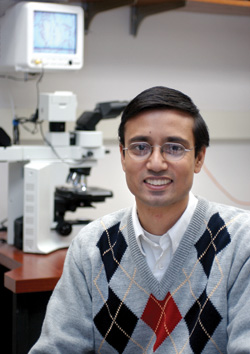
Neil A. Bhowmick, Ph.D./Photo by Dana Johnson
Findings offer clue to how molecule can stimulate, suppress growth
Scientists are puzzled by the fact that the molecule known as transforming growth factor-beta (TGF-b) generally stops cells from multiplying but at other times promotes cell growth.
Dr. Harold L. Moses, director of the Vanderbilt-Ingram Cancer Center, and his lab identified TGF-b in 1985 as both a growth stimulator and growth suppressor. Since that time, its role in colon, breast and other cancers has been studied extensively at Vanderbilt and elsewhere.
Now a team of researchers at Vanderbilt-Ingram has found a clue to the seemingly contradictory biological actions of TGF-b. Their findings are published online this week by the Proceedings of the National Academy of Science (www.pnas.org) and is expected to appear in the print version later this month.
“TGF-b usually causes cell growth inhibition; however, many solid tumors over-express TGF-b and the cells aren’t inhibited at all – in fact, sometimes they grow faster than normal as a result of TGF-b signaling,” said Neil A. Bhowmick, Ph.D., assistant professor of Urologic Surgery and senior author on the paper. “Many researchers have studied the ways in which TGF-b suppresses cell growth but not many have examined how it promotes cell growth.”
The researchers studied normal cell lines whose growth was inhibited by TGF-b — the process was working properly – as well as cell lines whose growth was stimulated by TGF-b.
TGF-b uses multiple signaling pathways to get its instructions to the cell’s nucleus – at least four pathways that are known, and there are probably more, Bhowmick said.
In the inhibited cells, the researchers removed particular protein components in one of these known TGF-b signaling pathways called Rho-ROCK. The cells were no longer inhibited and instead began growing again.
Then they did the opposite, adding the protein components to cells whose growth was being stimulated by TGF-b to see if their growth would be arrested again – that is, if normal TGF-b function would be restored by restoring the pathway. “Lo and behold, that’s exactly what happened,” Bhowmick said.
The findings suggest that the Rho-ROCK signaling pathway, traditionally known for its involvement in cell differentiation and defining cell shape, plays a key role in TGF-b inhibition of cell growth. “Perhaps inactivation of this pathway is a way that cancer cells override the normal growth-suppressing activity of TGF-b,” Bhowmick said.
More work is needed to fully understand the implications, but the findings also suggest a potential target for therapeutic intervention to restore TGF-b’s ability to inhibit cell growth, he said.
Bhowmick’s co-authors on the paper were Mayshan Ghiassi, Mary Aakre, Kimberly Brown, Vikas Singh and Moses, of the department of Cancer Biology and the Frances Williams Preston Laboratories, supported by the T.J. Martell Foundation at Vanderbilt-Ingram.
The work was supported by the U.S. Department of Defense, the National Cancer Institute and the Vanderbilt-Ingram Cancer Center.













